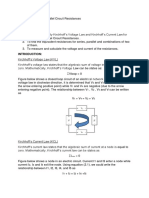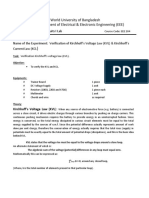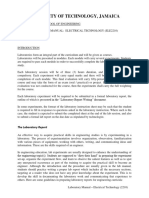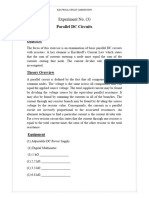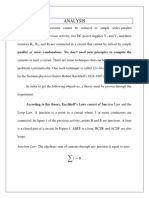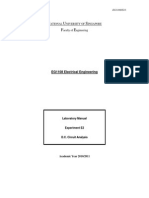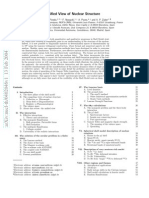EEE3100 Lab 3 PDF
Uploaded by
Putri SaidatinaEEE3100 Lab 3 PDF
Uploaded by
Putri SaidatinaTechnology of Electrical and Electronic
EEE3100
Semester 2
2015/2016
LAB 3
SERIES AND PARALLEL CIRCUIT RESISTANCES
3.1
Objectives
(a) To be able to apply Kirchhoffs Voltage Law and Kirchhoffs Current Law
for Series and Parallel Circuit Resistances
(b) To find the equivalent resistances for series, parallel and combinations of
two of them
(c) To measure and calculate the voltage and current of the resistances
3.2 Equipments and components
(a) DC Power Supply
(b) Digital Multimeter
(c) Resistors
(d) Breadboard
(e) Connecting wires and Probes
3.3 Introduction
3.3.1 Kirchhoffs Voltage Law (KVL)
Kirchhoffs voltage law states that the algebraic sum of voltage in a loop is equal to
zero. Mathematically, Kirchhoffs VoltageLaw can be states as
Vloop = 0
Figure below shows a closed loop circuit of an electrical network. Using Kirchhoffs
voltage law in clockwise direction, it is determined that V2 and V3 are positive (due to
the arrow entering positive point) while V1 and V4 are negative (due to the arrow
entering negative point). The relationship between V1 , V2 , V3 and V4 can be written
as
V1 V4 V2 V3
Dr. Nashiren Farzilah Mailah
EEE Dept., FK, UPM
Technology of Electrical and Electronic
EEE3100
V4
V2
Semester 2
2015/2016
V3
V1
3.3.2 Kirchhoffs Current Law (KCL)
Kirchhoffs current law states that the algebraic sum of current at a node is equal to
zero. Mathematically, Kirchhoffs current law can be states as
Inode = 0
Figure below shows a node in an electric circuit. Current I1 and I3 enter a node while
current I2, I4 and I5 exit the node. Using equation (2.1), we could write the
relationship between I1, I2, I3, I4, and I5 as
I1 I 3 I 2 I 4 I 5
I3
I1
I5
I4
I2
Dr. Nashiren Farzilah Mailah
EEE Dept., FK, UPM
Technology of Electrical and Electronic
EEE3100
3.4
Semester 2
2015/2016
Procedures
3.4.1 Series and Parallel Circuit
Figure 3.4.1
1. Read and take note the values of the resistors.
2. Calculate theoretically the voltages V AB , V BC , VCD and current I T in Figure
3.4.1 if the given voltage is E = 6 V.
3. Show theoretically that Kirchoffs voltage law holds for both loops in the circuit
in Figure 3.4.1 by calculating the voltages across resistance R1 , R2 , R3 and
R4 .
4. Assemble the circuit in Figure 3.4.1 and set the voltage supply at 6V.
5. Using multimeter at suitable range, measure the voltages across resistance R1 ,
R2 , R3 , R4 and the voltage supply E. Also measure the current that flows
through resistance R1 , R2 , R3 , R4 . Note down your measurement in Table 3.1.
(Warning: Ensure that the multimeter polarity is correct while making
measurements)
6. Prove Kirchhoffs voltage law for both loops in Figure 3.2 from this experiment
by measuring voltage across R1 , R2 , R3 , R4 .
7. Repeat the theoretical calculations for different values of voltage supply E as
well as the measurement and note down answers in Table 3.1.
8. Discuss your observations gathered from this experiment.
Dr. Nashiren Farzilah Mailah
EEE Dept., FK, UPM
Technology of Electrical and Electronic
EEE3100
Semester 2
2015/2016
Table 3.1 Measurement data for proving Kirchhoffs voltage law
E=6V
E = 12 V
E = 15 V
calculation measurement calculation measurement calculation measurement
E
VR1
VR2
VR3
VR4
IR1
IR2
IR3
IR4
Dr. Nashiren Farzilah Mailah
EEE Dept., FK, UPM
You might also like
- Lithium Ion Battery Identification ReferenceNo ratings yetLithium Ion Battery Identification Reference5 pages
- Lab 4 Kirchoff Law Sea19029, Sea19004, Sea19027No ratings yetLab 4 Kirchoff Law Sea19029, Sea19004, Sea1902714 pages
- Kirchhoff's Voltage and Current Laws: Prelab QuestionsNo ratings yetKirchhoff's Voltage and Current Laws: Prelab Questions9 pages
- Experimental Verification of Superposition TheoremNo ratings yetExperimental Verification of Superposition Theorem6 pages
- LAB-3-20062022-113914am-10032023-093231am-05032024-031447pmNo ratings yetLAB-3-20062022-113914am-10032023-093231am-05032024-031447pm4 pages
- Mutah University The Faculty of Engineering Mechanical Engineering DepartmentNo ratings yetMutah University The Faculty of Engineering Mechanical Engineering Department32 pages
- Electrical Circuits I Laboratory Kirchhoff'S Laws Applied in A Two Source CircuitNo ratings yetElectrical Circuits I Laboratory Kirchhoff'S Laws Applied in A Two Source Circuit11 pages
- Lab 2 - Kirchoff's current and voltage laws(1)100% (1)Lab 2 - Kirchoff's current and voltage laws(1)8 pages
- Laboratory 5: Kirchhoff's Voltage and Current LawsNo ratings yetLaboratory 5: Kirchhoff's Voltage and Current Laws6 pages
- Sulaimani Polytechnic University Engineering Technical College Communication DepartmentNo ratings yetSulaimani Polytechnic University Engineering Technical College Communication Department12 pages
- Experiment Id No 05: Bansal Institute of Science and Technology, Bhopal D E & E ENo ratings yetExperiment Id No 05: Bansal Institute of Science and Technology, Bhopal D E & E E3 pages
- Lab Assignment Lab Report_Parallel and Series Parallel CircuitsNo ratings yetLab Assignment Lab Report_Parallel and Series Parallel Circuits14 pages
- World University of Bangladesh Department of Electrical & Electronic Engineering (EEE)No ratings yetWorld University of Bangladesh Department of Electrical & Electronic Engineering (EEE)5 pages
- IEC Exp 2 Verification of Kirchoff's Voltage Law (KVL) and Kirchoff's Current Law (KCL)No ratings yetIEC Exp 2 Verification of Kirchoff's Voltage Law (KVL) and Kirchoff's Current Law (KCL)4 pages
- Experimental Verification of Kirchoff's LawsNo ratings yetExperimental Verification of Kirchoff's Laws7 pages
- Experiment 1: Ohm'S Law: V Ir V Voltage, R Resistance, I CurrentNo ratings yetExperiment 1: Ohm'S Law: V Ir V Voltage, R Resistance, I Current5 pages
- Urdaneta City University College of Engineering and ArchitectureNo ratings yetUrdaneta City University College of Engineering and Architecture10 pages
- Faculty Of Electrical Engineering Universiti Teknologi Mara: ii) 1.5 k Ω - 2 pcs iii) 3.3 kΩ - 1 pcsNo ratings yetFaculty Of Electrical Engineering Universiti Teknologi Mara: ii) 1.5 k Ω - 2 pcs iii) 3.3 kΩ - 1 pcs5 pages
- DC Lab - Exp - 3 - Student - Manual (Spring 22-23)No ratings yetDC Lab - Exp - 3 - Student - Manual (Spring 22-23)3 pages
- Advantage of Kirchhoff Law in Electrical CircuitNo ratings yetAdvantage of Kirchhoff Law in Electrical Circuit4 pages
- Experiment 3: To Verify Kirchhoff's Voltage and Current Laws ExperimentallyNo ratings yetExperiment 3: To Verify Kirchhoff's Voltage and Current Laws Experimentally3 pages
- To: Professor Darish Date: October 7, 2014: V V V +VNo ratings yetTo: Professor Darish Date: October 7, 2014: V V V +V5 pages
- Design of Electrical Circuits using Engineering Software ToolsFrom EverandDesign of Electrical Circuits using Engineering Software ToolsNo ratings yet
- Of Lipid Science and Technology, 109 (4), 336-349No ratings yetOf Lipid Science and Technology, 109 (4), 336-3491 page
- Title: The Effect of Water Supply Disruption To The Residents of Tenth and Eleventh College AuthorNo ratings yetTitle: The Effect of Water Supply Disruption To The Residents of Tenth and Eleventh College Author2 pages
- A C C I D E N T S: - Disability - Death - Personal Suffering - Loss of IncomeNo ratings yetA C C I D E N T S: - Disability - Death - Personal Suffering - Loss of Income1 page
- Bbi2424 SCL Task 5 Active and Passive Voice450% (4)Bbi2424 SCL Task 5 Active and Passive Voice43 pages
- 3a. Orthographic Projection - Multiview ProjectionNo ratings yet3a. Orthographic Projection - Multiview Projection31 pages
- Heat and Mass Transfer: Fundamentals & Applications: Errata SheetNo ratings yetHeat and Mass Transfer: Fundamentals & Applications: Errata Sheet6 pages
- Main Switchboard: Burma Shipyard Hull No.No ratings yetMain Switchboard: Burma Shipyard Hull No.27 pages
- Study The Rheological and Mechanical Properties of PVANo ratings yetStudy The Rheological and Mechanical Properties of PVA7 pages
- Investigation of The Relationship Between Load and Loss Factors For A Brazilian Electric Utility (Oliveira2006) PDFNo ratings yetInvestigation of The Relationship Between Load and Loss Factors For A Brazilian Electric Utility (Oliveira2006) PDF6 pages
- 5th Sem. B. Tech. - Power Station Practice - BEEE505T - 30 JuneNo ratings yet5th Sem. B. Tech. - Power Station Practice - BEEE505T - 30 June3 pages
- Communicating Climate Change Why Frames Matter for Public EngagementNo ratings yetCommunicating Climate Change Why Frames Matter for Public Engagement13 pages
- Mechanical Technology PAT GR 12 2024 (Automotive) EngNo ratings yetMechanical Technology PAT GR 12 2024 (Automotive) Eng48 pages
- Liquid Drop Model and Bohr-Wheeler Theory of Nuclear Fission100% (1)Liquid Drop Model and Bohr-Wheeler Theory of Nuclear Fission6 pages
- The Shell Model As Unified View of Nuclear StructureNo ratings yetThe Shell Model As Unified View of Nuclear Structure64 pages
- Burgmann Quick Guide To Identifying Mechanical Seal Failures100% (1)Burgmann Quick Guide To Identifying Mechanical Seal Failures1 page
- (Springer Series in Materials Science 200) Ilya V. Shadrivov, Mikhail Lapine, Yuri S. Kivshar (Eds.) - Nonlinear, Tunable and Active Metamaterials-Springer International Publishing (2015) PDFNo ratings yet(Springer Series in Materials Science 200) Ilya V. Shadrivov, Mikhail Lapine, Yuri S. Kivshar (Eds.) - Nonlinear, Tunable and Active Metamaterials-Springer International Publishing (2015) PDF333 pages
- A1120/40 Polyphase Phase Meter: End User's GuideNo ratings yetA1120/40 Polyphase Phase Meter: End User's Guide21 pages
- Generac Doosan 22.0 Liter V12 Diesel 22.0DTA Generator Engine Parts ManualNo ratings yetGenerac Doosan 22.0 Liter V12 Diesel 22.0DTA Generator Engine Parts Manual63 pages
- Fintech and Sustainable Development Assessing The ImplicationsNo ratings yetFintech and Sustainable Development Assessing The Implications90 pages
- AM072BXVGFHAA Submital DVM+S2 230V HP 05232022ANo ratings yetAM072BXVGFHAA Submital DVM+S2 230V HP 05232022A2 pages
- Kirchhoff's Voltage and Current Laws: Prelab QuestionsKirchhoff's Voltage and Current Laws: Prelab Questions
- Experimental Verification of Superposition TheoremExperimental Verification of Superposition Theorem
- LAB-3-20062022-113914am-10032023-093231am-05032024-031447pmLAB-3-20062022-113914am-10032023-093231am-05032024-031447pm
- Mutah University The Faculty of Engineering Mechanical Engineering DepartmentMutah University The Faculty of Engineering Mechanical Engineering Department
- Electrical Circuits I Laboratory Kirchhoff'S Laws Applied in A Two Source CircuitElectrical Circuits I Laboratory Kirchhoff'S Laws Applied in A Two Source Circuit
- Laboratory 5: Kirchhoff's Voltage and Current LawsLaboratory 5: Kirchhoff's Voltage and Current Laws
- Sulaimani Polytechnic University Engineering Technical College Communication DepartmentSulaimani Polytechnic University Engineering Technical College Communication Department
- Experiment Id No 05: Bansal Institute of Science and Technology, Bhopal D E & E EExperiment Id No 05: Bansal Institute of Science and Technology, Bhopal D E & E E
- Lab Assignment Lab Report_Parallel and Series Parallel CircuitsLab Assignment Lab Report_Parallel and Series Parallel Circuits
- World University of Bangladesh Department of Electrical & Electronic Engineering (EEE)World University of Bangladesh Department of Electrical & Electronic Engineering (EEE)
- IEC Exp 2 Verification of Kirchoff's Voltage Law (KVL) and Kirchoff's Current Law (KCL)IEC Exp 2 Verification of Kirchoff's Voltage Law (KVL) and Kirchoff's Current Law (KCL)
- Experiment 1: Ohm'S Law: V Ir V Voltage, R Resistance, I CurrentExperiment 1: Ohm'S Law: V Ir V Voltage, R Resistance, I Current
- Urdaneta City University College of Engineering and ArchitectureUrdaneta City University College of Engineering and Architecture
- Faculty Of Electrical Engineering Universiti Teknologi Mara: ii) 1.5 k Ω - 2 pcs iii) 3.3 kΩ - 1 pcsFaculty Of Electrical Engineering Universiti Teknologi Mara: ii) 1.5 k Ω - 2 pcs iii) 3.3 kΩ - 1 pcs
- DC Lab - Exp - 3 - Student - Manual (Spring 22-23)DC Lab - Exp - 3 - Student - Manual (Spring 22-23)
- Experiment 3: To Verify Kirchhoff's Voltage and Current Laws ExperimentallyExperiment 3: To Verify Kirchhoff's Voltage and Current Laws Experimentally
- To: Professor Darish Date: October 7, 2014: V V V +VTo: Professor Darish Date: October 7, 2014: V V V +V
- Design of Electrical Circuits using Engineering Software ToolsFrom EverandDesign of Electrical Circuits using Engineering Software Tools
- Title: The Effect of Water Supply Disruption To The Residents of Tenth and Eleventh College AuthorTitle: The Effect of Water Supply Disruption To The Residents of Tenth and Eleventh College Author
- A C C I D E N T S: - Disability - Death - Personal Suffering - Loss of IncomeA C C I D E N T S: - Disability - Death - Personal Suffering - Loss of Income
- 3a. Orthographic Projection - Multiview Projection3a. Orthographic Projection - Multiview Projection
- Heat and Mass Transfer: Fundamentals & Applications: Errata SheetHeat and Mass Transfer: Fundamentals & Applications: Errata Sheet
- Study The Rheological and Mechanical Properties of PVAStudy The Rheological and Mechanical Properties of PVA
- Investigation of The Relationship Between Load and Loss Factors For A Brazilian Electric Utility (Oliveira2006) PDFInvestigation of The Relationship Between Load and Loss Factors For A Brazilian Electric Utility (Oliveira2006) PDF
- 5th Sem. B. Tech. - Power Station Practice - BEEE505T - 30 June5th Sem. B. Tech. - Power Station Practice - BEEE505T - 30 June
- Communicating Climate Change Why Frames Matter for Public EngagementCommunicating Climate Change Why Frames Matter for Public Engagement
- Mechanical Technology PAT GR 12 2024 (Automotive) EngMechanical Technology PAT GR 12 2024 (Automotive) Eng
- Liquid Drop Model and Bohr-Wheeler Theory of Nuclear FissionLiquid Drop Model and Bohr-Wheeler Theory of Nuclear Fission
- The Shell Model As Unified View of Nuclear StructureThe Shell Model As Unified View of Nuclear Structure
- Burgmann Quick Guide To Identifying Mechanical Seal FailuresBurgmann Quick Guide To Identifying Mechanical Seal Failures
- (Springer Series in Materials Science 200) Ilya V. Shadrivov, Mikhail Lapine, Yuri S. Kivshar (Eds.) - Nonlinear, Tunable and Active Metamaterials-Springer International Publishing (2015) PDF(Springer Series in Materials Science 200) Ilya V. Shadrivov, Mikhail Lapine, Yuri S. Kivshar (Eds.) - Nonlinear, Tunable and Active Metamaterials-Springer International Publishing (2015) PDF
- Generac Doosan 22.0 Liter V12 Diesel 22.0DTA Generator Engine Parts ManualGenerac Doosan 22.0 Liter V12 Diesel 22.0DTA Generator Engine Parts Manual
- Fintech and Sustainable Development Assessing The ImplicationsFintech and Sustainable Development Assessing The Implications










